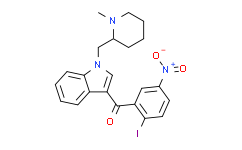| Cas No.: | 444912-48-5 |
| Chemical Name: | (2-Iodo-5-nitrophenyl)(1-((1-methylpiperidin-2-yl)methyl)-1H-Indol-3-yl)methanone |
| Synonyms: | (2-Iodo-5-nitrophenyl)(1-((1-methylpiperidin-2-yl)methyl)-1H-Indol-3-yl)methanone;AM1241;(2-Iodo-5-nitrophenyl)[1-[(1-methyl-2-piperidinyl)methyl]-1H-indol-3-yl]methanone;(r,s)-am1241;AM-1241;(R,S)-3-(2-Iodo-5-nitrobenzoyl)-1-(1-methyl-2-piperidinylmethyl)-1H-indole |
| SMILES: | O=[N+]([O-])C1=CC(=C(I)C=C1)C(=O)C2C3C(=CC=CC=3)N(CC4N(C)CCCC4)C=2 |
| Formula: | C22H22N3O3I |
| M.Wt: | 503.33238 |
| Purity: | >98% |
| Sotrage: | 2 years -20°C Powder, 2 weeks 4°C in DMSO, 6 months -80°C in DMSO |
| Description: | AM1241 is a potent, typical[2] and selective CB2 receptor agonist, with a Ki of 3.4 nM in a mouse spleen, and the Ki for CB1 receptor in rat brain is 280 nM, 82-fold selectivity for the CB2 receptor in rodent tissue[1]. AM1241 relieves migraine, stroke, and neuropathic pain,also has a potent effect on Parkinson's disease[2]. AM1241 prevents oxidative damage and activates STAT3 through the phosphorylation of Akt and Erk1/2[3]. |
| Target: | Ki: 3.4 nM (Mouse spleen CB2 receptor), 280 nM (Rat brain CB1 receptor)[1] |
| In Vivo: | AM1241 (0.1-3 mg/kg, i.p.) dose-dependently inhibits sensory hypersensitivity in rats. AM1241 inhibits tactile hypersensitivity and thermal hypersensitivity at 1 mg/kg and 3 mg/kg, respectively, in mice lacking the CB1 receptor[1]. AM1241 (0.75, 1.5, 3, 6, 12 mg/kg, i.p.) alleviates MPTP-induced Parkinson's disease and promotes the regeneration of dopaminergic (DA) neurons in PD mice[2]. |
| In Vitro: | AM1241 is a potent and selective CB2 receptor agonist, with a Ki of 3.4 nM in a mouse spleen, and the Ki for CB1 receptor in rat brain is 280 nM, 82-fold selectivity for the CB2 receptor in rodent tissue[1]. AM1241 decreases oxidative stress levels, enhances the production of paracrine growth factors, decreases TGF-β1 and PDGF levels, activates Stat3 via the phosphorylation of Akt and Erk1/2[3]. |
| References: | [1]. Ibrahim MM, et al. Activation of CB2 cannabinoid receptors by AM1241 inhibits experimental neuropathic pain: pain inhibition by receptors not present in the CNS. Proc Natl Acad Sci U S A. 2003 Sep 2;100(18):10529-33. [2]. Shi J, et al. AM1241 alleviates MPTP-induced Parkinson's disease and promotes the regeneration of DA neurons in PD mice. Oncotarget. 2017 Jun 29;8(40):67837-67850. [3]. Han D, et al. Activation of cannabinoid receptor type II by AM1241 protects adipose-derived mesenchymal stem cells from oxidative damage and enhances their therapeutic efficacy in myocardial infarction mice via Stat3 activation. Oncotarget. 2017 May 4;8(39):64853-64866. |

 To enhance service speed and avoid tariff delays, we've opened a US warehouse. All US orders ship directly from our US facility.
To enhance service speed and avoid tariff delays, we've opened a US warehouse. All US orders ship directly from our US facility.




















